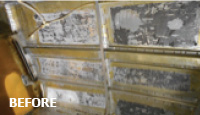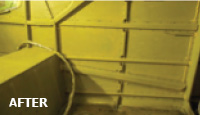Aircraft Corrosion – Just a Nuisance, or a Major Problem?
By Dennis Wolter, Founder / Owner, AIR MOD


The most irreversible threat to the longevity of the airplanes we love is corrosion. Is it just a nuisance or a major problem? It depends on how long it is left untreated and where it is.
Find It, Slow It Down, and Stop It
Cabin areas are particularly corrosion-prone. Keeping water out of the cabin is very important. Take a little moisture in the form of humidity, plus a little salt from your Florida vacation, added to a long winter’s nap in a damp hangar, and there’s ample opportunity for corrosion to form. We’ve all heard that ocean-based airplanes are corrosion buckets, but you don’t have to live oceanside. If your airplane is exposed to salt air during even one visit, salt crystals will remain inside and cause corrosion.
The first stage of corrosion can be seen in a darkening of the metal, for instance, when a polished bare metal airplane sits outside and begins to look dull. The second stage is the presence of visible aluminum oxide in the form of a gray powder or crust. The third and most advanced stage of corrosion exists when crusty oxidation is removed to reveal severe pitting, cracks, or holes in the metal surface.
Cabin Areas Are Particularly Corroson-Prone
Closely inspect, then remove and treat any corrosion you find. Check the upper cabin in high wing airplanes; lower cabin areas in low wing planes. You’ll find most problems in critical floor and wing attachments. Check the door latches and seals, the windshield and windows for leaks, floors, carpets, and seat rails. If you see any corrosion, keep looking, you’ll probably find more.
Corrosion is dealt with on three levels: prevention, removal, and treatment. The overall goal is to take a surface from corroded to cleaned, treated, and chromated.
A few steps you can take: treat with an anti-corrosion spray, wash your airplane after an ocean trip, keep landing gear wells and bellies de-greased/ cleaned, properly maintain all door/ window seals, and keep drain holes/ battery box drain hoses open.
A heated hangar is unquestionably the best storage for corrosion control, but insulated hangars are the next best choice. Outside, a hard surface is better than grass. Keep animals out. Get your aircraft painted using a qualified shop to avoid future corrosion.
Corrosion can occur anywhere, so keep your eyes open and be tenacious in your efforts to find it. Know that intermittent electrical problems can often be traced to the presence of corrosion. Re-inspect and evaluate at every annual to check that your efforts effectively reduced or eliminated the corrosion. Whether you attempt to do this work yourself or engage the services of a qualified shop, few of us could argue it’s a wise investment.
For more on corrosion, refer to chapter 6 in AC 43.13-1B, Acceptable Methods, Techniques, and Practices – Aircraft Inspection and Repair (bit.ly/3dGWJzN), a great source of information published by the FAA and a must-have for anyone working on an airplane.
Dennis Wolter is the 2020 National General Aviation Technician of the Year Award winner and founder of Air Mod, a full-service aircraft renovation company in Batavia, Ohio. He contributes his aircraft renovation expertise in seminars and aviation publications.
Reprinted with permission from FAA Safety Briefing. Visit the Flight Safety Briefing website: https://www.faa.gov/news/safety_briefing/.



